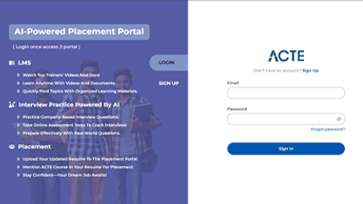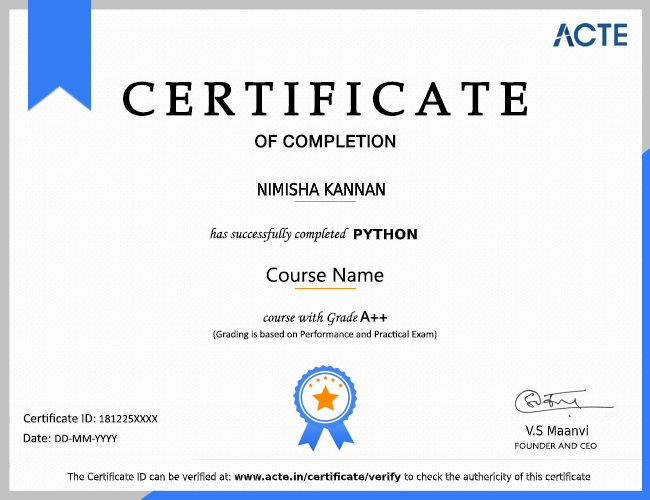Python is considered to be the most job-intensive programming language Researchers have called Python "the next big thing," as many young and seasoned developers love and are very rewarded by every language in the field of IT planning. We Offers a comprehensive Python Course in Bhubaneswar that will help with master principles and advanced theoretical concepts such as writing scripts, sequence, and Python file operations while also providing practical experience in the functional applications, since the training is combined with tasks and live projects.
We focus on providing the best python training with more expanded practical sessions. As the need for competent persons in the IT business develops, professionals and students seize this chance with their open arms. We make sure you're not dissatisfied when we provide the most updated, comprehensive training module with practical sessions with a 100% cashback guarantee when you are prepared to improve your coding skills and are actively looking for the top Python training college.
Additional Info
Why you choose Python?
Python is one of the leading high-level programs which developers have been using for a long time. Python is a dynamic language focused on the rapid development of applications. Compared to other programming languages such as Java or C++, it offers developers a simple syntax and code. Python is one of the languages with the fastest growth.
Advantages of Choosing Python for Real-time Applications
1. It’s Free :
Python is a programming language that is open source and free to use. No customized platform is required. This language is therefore compatible with desktops and laptops. Python offers completely free modules and libraries.
2. Compatibility :
Python is highly compatible with software applications in real-time. Micro-Python is a version that explicitly operates in microcontrollers such as ARM Cortex-M3/4 for real-time applications.
3. Data Analyser :
Many free libraries are available to develop applications in real-time. The important information is used for analysis in the language stored locally or in the database. The best part of the analysis is that the foundation is done well before time.
4. Extensive Libraries :
Python is made up of several extensive libraries for String Operations, the Internet, web services, the interface of the operating system, and conventions. Python's highly used programming tasks are pre-scripts, which restrict the length of the Python codes.
5. Object-Oriented Language :
An object-oriented programming language is known as a programming language that can model the real world. It focuses on objects when data and functions are combined. On the other hand, the process-oriented language has various functions with reusable codes. The major advantage of Python language adaptation is that the programming languages are both process-oriented and object-oriented.
Roles and Responsibilities of Python :
A typical developer of Python designs, codes, and apps. Moreover, debug codes, integrated systems, etc are often required for the person. While these may be true, the roles and responsibilities of a Python developer depend on their work profile, industry or vertical, and work experience. Let us, therefore, explain the various categories of roles and responsibilities. The roles and responsibilities of a Python developer are based on the profile of the work :
- Effective, reusable, testable, and scalable code writing
- Comprehension, analysis, and implementation – Business requirements, requests for modification of features, transformation into software.
- User-oriented elements integration in various applications, data storage solutions
- Development of components that improve performance and receptivity, logic on the server and platform, statistical learning models, and web applications that respond greatly.
- Design and implementation – Applications for high availability and low latency, protection of data and safety
- Application performance control and automation
- Python test framework tools such as Behave, Pytest, PyUnit, etc to test and debug software applications.
- Improving current software systems functionality
- Digital tools for monitoring online traffic
- Working with libraries such as Pandas, NumPy, and so on.
- Creation of AI and ML-based predictive models
- Stay tuned to the latest technology and trends
- Finalize and develop algorithms based on results based on AI/ML
Required Skill of Python :
The Python programming language is one of the most used and sought-after in the industry. There are plenty of skills to become a good developer in Python. Here we discuss the best skills of a Python developer to be a Better Python developer.
1. Expertise in Core Python :
The developer should know Core Python very well. You should know the concepts and aspects of the core python:
- Iterators \sGenerators
- Management of exceptions
- Concepts for File Management
- Types of data and variables
- Concepts of OOPs
- Structures of data
2. Sound Knowledge of Web Frameworks :
Flask and Django are the most popular web framework of Python. One of these web frames should be very well understood by the developer. Flask is an extremely commonly used Python micro-web framework. In addition to the high-level Python web framework, Django promotes practical, clean & functionality. JavaScript, CSS, and HTML knowledge is also helpful in becoming a Good Python Developer.
3. Object Relational Mappers :
An object-based Programming language is used to convert data between two incompatible systems called an Object Relational Mapper (ORM). An Object Relational Mappers creates a virtual object database from any programming language. Programmers also use several custom ORM tools.
4. Artificial Intelligence and Machine Learning Skill :
A data science developer should be well aware of artificial intelligence and machine learning in the data sciences. Good skills in machine learning algorithms should be required. He should be familiar with neural networks and should be able to obtain insights from data, visualize data, analyse data and collect data from different sources.
Tools of Python :
The best way to learn any language is to decide what you want to build. The next thing you need to find is a course or some resources to help you learn to find an enormous number of Python programming tools or other languages. Let's visit some of the best python learning tools or websites.
Real Python :
If both Python and Web development are to be learned by using Python it is good to stick with Real Python Course. The course begins with the basics of the Python language and continues with Django, Flask, and Web2py web development. Not only will you learn these frameworks but also Git and Heroku, who will build and send your code once the code has been finished.
Learn Python the Hard Way :
This classic is a software developer and the creator of the Ruby Mongrel web server and is mainly the eBook of Zed Shaw. It's a simple formula of three steps.
- Pass every exercise
- Type exactly in each example
- Just let it go!
Yeah, it's hard to make it. Yes, that's going to be a little frustrating. It's valuable, however.
Intro to Python for Data Science (Data Camp) :
There is another batch of the same size that wants to learn Python for data science as many people want to learn Python for web development. You should learn more than anything for a career in data science. This course also provides you with insights into this.
Python Anywhere :
If you are completely new and you are having difficulties installing and configuring Python on your system, start Python Anywhere and learn the basics and then go back to the installation process later. It is an environment with full Python functionality in your web browser.
Frameworks of Python :
Due to its strong focus on efficiency and readability, Python is one of Web and app developers' most acceptable languages. There are many exceptional Python Web frameworks, each with its features and specialties.
- Django :
Here we describe some of the Django framework's necessary details and features. Category − Django is part of the Python Framework full-stack. Release − Release 2.1, commonly utilized version – 1.8, 1.6.
Approaching − Django is a high-level Python web framework created by experienced developers, enabling rapid, clean, and pragmatic design development. In order, you can focus on writing your app without reinventing the wheel, Django handles many of the complexities of Web development. It's open and free. Django uses ORM for mapping objects to the database table and the same for transferring them from one database into another.
- Flask :
Category − Flask belongs to frameworks of non-full-stack. Published in 2018-05-02. Release − 1.0.2 . Approaching − It is classified as a micro-framework because no libraries or tools are needed. It has no form validation or abstract database layer or other components where previous libraries provide common functions. There are no other components. Flask supports several extensions, however, which extend the application functions like Flask itself implements. Extensions for object-relation mappers, validation of the form, handling of uploads, various open automation technologies, and various common tools related to frameworks exist.
- Web2py :
Category − Web2py is part of the family full-stack frameworks. Published on 2018-08-06 Release − 2.17.1, Approximately - Python 2.6, 2.7 Python 3.x. It is a complete package itself without further dependencies. The web interface can be used for developing, administering data databases, debugging, deploying, testing, and maintaining applications, but generally not necessary. It has its own web-based IDE, code editor, one-click deployment, and debugger. It is a scalable open-source environment.
Integration Modules of Python :
You can find out in this cookbook how to integrate azimuth with the Python interpreter. The first part uses pure Python and the second uses some advanced Jupyter notebook features. The other part is distributed in two parts.
Integration of Python with Hadoop and Spark :
Whether small or large, Python has different built-in features to support data processing. The processing of unstructured and unconventional data is supported. That is why data scientists and big data companies prefer to pick Python as one of the most important data processing requirements. Other technology can also be more effective than python in processing big data. It's Spark and Hadoop.
1. Hadoop :
Based on the distributed file system model, the Hadoop file system was developed. It works on hardware for commodities. HDFS is extremely defective tolerant and designed with cheap hardware, as opposed to different distributed systems.
HDFS holds a large number of data and also facilitates access to them. The files are stored in multiple systems to store such a large amount of data. These files are stored redundantly in the event of failure, in order to rescue the system from potential data losses. HDFS also makes multi-processing applications available.
- It is responsible for the storage and processing of data on a cluster.
- Users can easily check for the status of the cluster with the name and knowledge node data servers.
- By default, every block is repeated 3 times. Replicas on totally different nodes are saved.
- Hadoop Streaming acts like a bridge between the Java HDFS code and your Python code, enabling Hadoop Clusters to be accessed seamlessly and MapReduce tasks executed.
- HDFS allows and authenticates files.
2. Apache Spark :
Apache Spark is a large-scale structure or unstructured data processing data open-source data analysis engine. The Apache Spark community had released a tool called PySpark to work with Python including the Spark features. The Spark Python API (PySpark) reveals to Python the model of Spark programming. We can work in the Python programming language with RDDs by using the PySpark. A library called Py4j is attributable to the ability to achieve this.
Certifications of Python :
To provide programming specialists, software developers, and IT professionals from all over the world with the means for objective assessment, documenting, and recognition of their programming skills, the Python Institute is committed to developing its independent global standard for the Python Program Certification. In order to provide Python Program Certification Program, OpenEDG Python Institute and Pearson VUE, the computer-based exam leader, partnered.
- PCEP – Certified Entry-Level Python Programmer :
PCEP - Certified Python programmer input level certification indicates that individuals are familiar with universal computer programs, such as data types, containers, features, conditions, loops and syntax, semantics, and runtime environment of Python programming language.
- PCAP – Certified Associate in Python Programming :
PCAP – Python Program Certified Associate, provides trust in your planning skills and helps you stand out in the labor market. As a complement to your education, the PCAP certification offers you a headstart to prepare and advance to the professional level.
- PCPP1 – Certified Professional in Python Programming 1 :
PCPP1 – Python Programmable Certified Professional 1 recognizes advanced expertise and expertise in Python programming. The certification of PCPP1 reflects your experience and programming skills in the following fields: Advanced OOP, GUI Programming, PEP Best Practices, Text File Processing, Program Contacts, and RESTful APIs. It shows you take your career seriously and allows you to distinguish yourself by having global credentials.
- PCPP2 – Certified Professional in Python Programming 2 :
PCPP2 – Python Program Certified Professional 2 certification reflects you're extensive in programming and related technological skills. The certificate PCPP2 shows that in the fields of the creation and distribution of packages, the design patterns, the IPC, network programming, and Python-MySQL database access you are acquainted with and knowledgeable. It shows that you have the highest degree of know-how and that you are passionate about Python programming.
Benefits of Python :
1. Versatility :
The advanced programming language will be used by each programmer to reduce the number of tasks involved. Because of its many features, Python is the best option for programmers. Therefore, it allows you to explore different sectors without Hassel with Python to build applications.
The user-friendly programming language can be used easily and can be developed more quickly. The nice and friendly language is well structured, as it helps quickly to complete the task. The ultimate advantage of using Python is the easy-to-learn feature that allows both new and experienced programmers to use it occasionally.
2. Open Source :
Not all technology in the world is free. Some of them require considerable payment to be used regularly. The language of programming is open source and free to use. It thus attracts many beginners to work from the early stages of programming. There is also a massive library for downloading scripts based on needs in the open-source language. Python is used for many applications since it is easy to use and features fewer protocols for coding.
3. Easy Integrations :
Thanks to its powerful control capabilities, Python is one of the best applications on the market for integration. Easy integration is one of the main advantages due to the absolute demands of Python. With C, C++, Java, and so on, Python can easily connect it. It also processes markup languages like XML because it supports efficient working for modern applications. It is a known fact that not all applications use a single language code for programming. In addition to certain features, the functionality needs an external code. Therefore, you can easily integrate the choice of a universal programming language.
4. Safety and Security :
Python does not come with specific pointers, unlike C-based programming languages. The programming language is more confident than other programming languages without any indicators. Since there are no indications in programming languages, it is clear that programmers would effectively monitor the failure of the program.
Pay scale of Python :
For any employee, wages are a decisive factor in the choosing of a job. Python's earnings vary depending on an individual's experience. The more a developer is experienced, the more attractive the salary it pays. In the case of a Python developer's pay, there are several other decisive aspects. Let's now take a look at India's average wage and pay trends. According to PayScale, a Python Developer's average wage is 427K. The figure is about 356k per month. The annual salary may be as high as 100K. On the other hand, depending on skills, experience, and work, the minimum salary maybe around 225K per year.
A Software Engineer with less than 1-year experience can expect to receive an average overall remuneration of a total of 552K based on 638 salaries (including tips, bonus, and overtime). A 1-4-year experience early software engineer earns an average total of CHF 622K on a total of 286K pay. A 5-9-year-old mid-career engineer earns an average overall salary of ₹ 161K for 409 wages. An experienced engineer with 10-19 years of experience earns an average full salary of 182K based on 98 employees. In their late-career (20 years and older), the average salary for employees is 600K in total.































